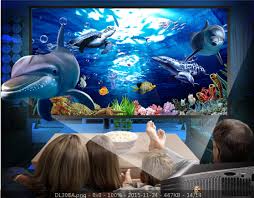3D movies have grown in popularity in recent years. With this growth, the demand for 3D-compatible tech has risen as well. OEMs have taken note of this market, and have upped the supply of 3D-ready and Full 3D projectors to the market.
The 3D projector category covers everything from old educational 3D projectors that are typically low resolution and low priced, to newer 1080p home projectors that retail anywhere from $1500 to over $7000.
Since 2011, the price of 3D projectors have plummeted due to the increased options, and projectors like the Panasonic PT-AE7000U (click for current price) and the Epson Home Cinema 3100 (click for current price) now provides pristine performance at low prices.
What is a 3D Projector?

A 3D projector is used to map three-dimensional data to a two-dimensional surface such as a screen or a wall. As opposed to images from a traditional projector, those from a 3D projection allows the viewer to sense depth. This feeling of depth lets the audience experience a simulation of the experience happening in real-time.
Two nearly identical images are projected onto the screen simultaneously to create this simulation of depth. Hence, to view the screen properly, you need a pair of glasses that can filter polarity, allowing you see both images with each eye. These 3D glasses are sometimes included with the projector package or can be bought standalone.
Types of 3D Projectors: Full 3D vs. 3D-ready Projectors
Like 2D projectors, 3D projectors are built using display technologies such as DLP and 3LCD. However, 3D projectors receive and project a different data stream type in a variety of formats.
3D videos are transmitted using four major formats: Frame Sequential, Frame Packing, Side-by-Side, and Checkerboard. The transmission format supported is the yardstick for dividing 3D projectors into two groups: Full 3D and 3D-ready projectors.
3D-Ready Projectors
Consumers often buy “3D ready” projectors only to be disappointed by their inability to view 3D with their projector. A faulty projector does not cause this but rather an uninformed purchase; as these buyers do not know what a 3D-Ready projector is.
3D-ready projectors are designed to handle only the Frame Sequential data transmission format. This design helps reduce production cost as frame sequential transmission is one of the simplest forms of 3D.
A frame sequential signal is sent as a full resolution picture at 120 frames per second. These frames alternate sequentially, sending a frame for the left eye, then another for the right eye, and so on. As a result of this simple setup, the projector does not need to decode the source data stream and can display the same directly. The only requirement for the projector is that it can accept 120Hz signals. As you would expect, this method of transmission is bandwidth extensive.
To use a 3D-ready projector, you need a computer that is equipped to transmit such data (e.g. NVIDIA’s 3D Vision system.) Unfortunately, a 3D-ready projector will not project 3D content from other computers or other 3D capable devices such as Blu-ray 3D players and set-top boxes.
Full 3D projectors
On the other hand, Full 3D projectors are capable of handling any of the four 3D content transmission formats. Full 3D projectors offer full 1080p 3D projection, and they are compatible with HDMI 1.4 or Blu-ray 3D. Before buying a Full 3D projector, ensure that these specifications are clearly stated by the OEM.
So if you want a 3D projector, you are likely looking for a full 3d projector!
Prices for Full 3D projectors start at $1500 with lower priced offerings like the Epson Home Cinema 3700.
Have you purchased a 3d-ready or full 3d projector? Let us know how they worked for you in the comments below.

